HR Planning Exam - HR Planning for Advertising Company in Ottawa
VerifiedAdded on 2021/04/13
|11
|3571
|32
Homework Assignment
AI Summary
This assignment presents a comprehensive HR planning exam for a manager at a growing advertising company in Ottawa. The exam addresses key HR challenges, including implementing a succession management program, assessing a potential acquisition of a smaller competitor, managing potential downsizing and outsourcing the HR recruiting function. The student is tasked with identifying and describing various management development techniques, explaining the importance of HR due diligence, analyzing the role of corporate culture in acquisitions, suggesting initiatives to mitigate the negative effects of downsizing on remaining employees, and evaluating the advantages and disadvantages of outsourcing the HR recruiting function. The assignment requires the application of relevant theories, concepts, and examples, along with references to peer-reviewed journal articles to support the recommendations and arguments. The exam emphasizes strategic HR planning to address the company's growth and changing business needs.
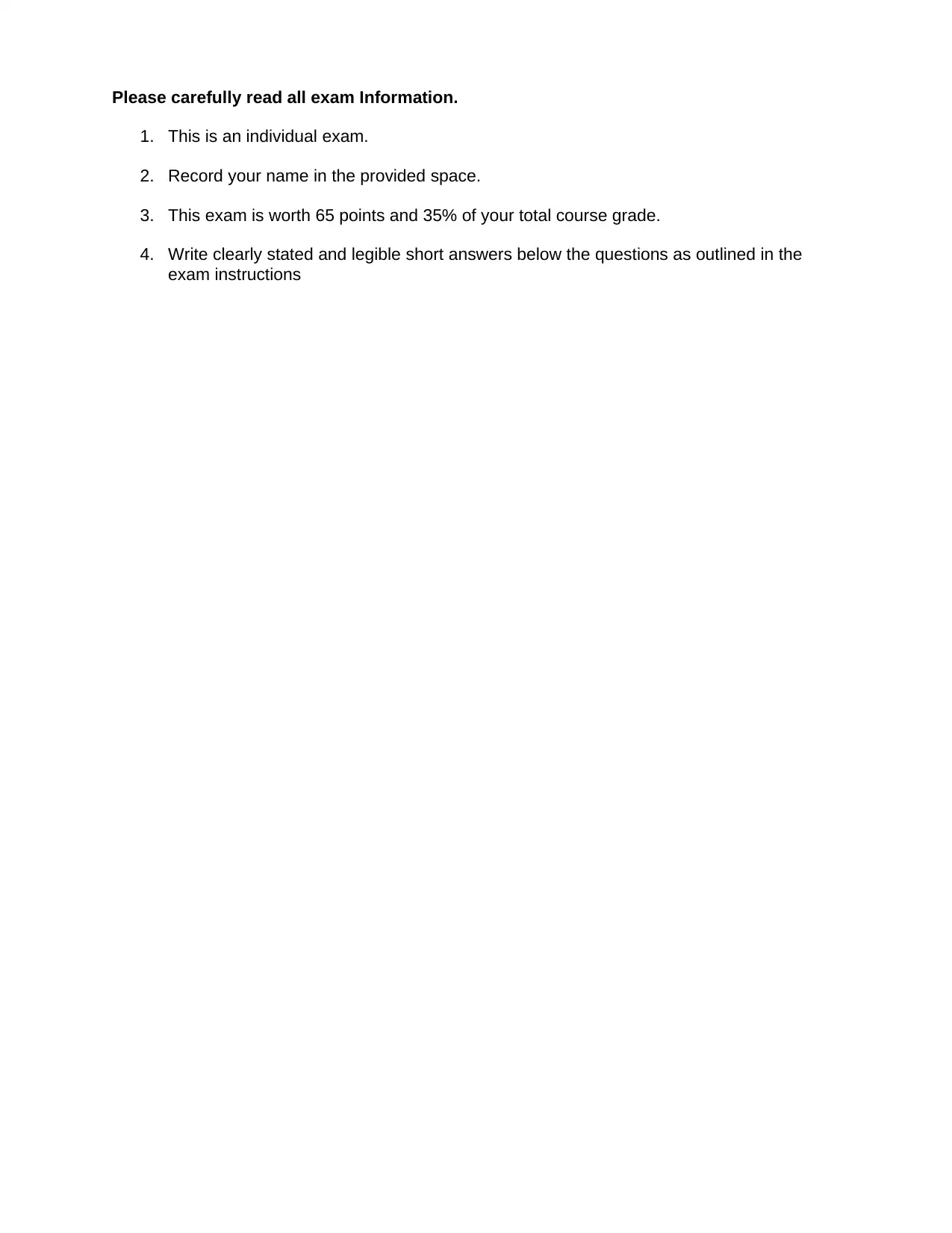
Please carefully read all exam Information.
1. This is an individual exam.
2. Record your name in the provided space.
3. This exam is worth 65 points and 35% of your total course grade.
4. Write clearly stated and legible short answers below the questions as outlined in the
exam instructions
1. This is an individual exam.
2. Record your name in the provided space.
3. This exam is worth 65 points and 35% of your total course grade.
4. Write clearly stated and legible short answers below the questions as outlined in the
exam instructions
Paraphrase This Document
Need a fresh take? Get an instant paraphrase of this document with our AI Paraphraser
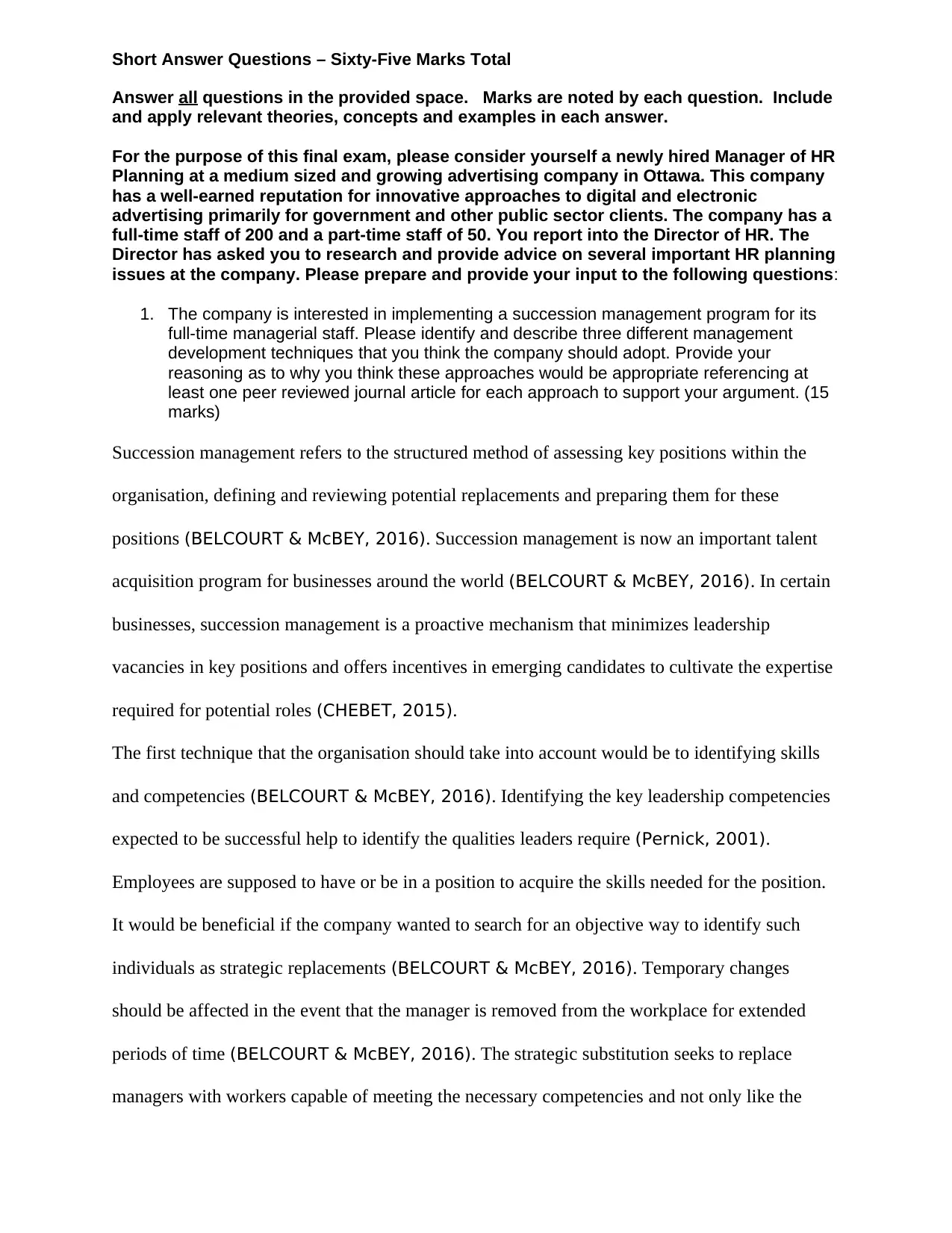
Short Answer Questions – Sixty-Five Marks Total
Answer all questions in the provided space. Marks are noted by each question. Include
and apply relevant theories, concepts and examples in each answer.
For the purpose of this final exam, please consider yourself a newly hired Manager of HR
Planning at a medium sized and growing advertising company in Ottawa. This company
has a well-earned reputation for innovative approaches to digital and electronic
advertising primarily for government and other public sector clients. The company has a
full-time staff of 200 and a part-time staff of 50. You report into the Director of HR. The
Director has asked you to research and provide advice on several important HR planning
issues at the company. Please prepare and provide your input to the following questions:
1. The company is interested in implementing a succession management program for its
full-time managerial staff. Please identify and describe three different management
development techniques that you think the company should adopt. Provide your
reasoning as to why you think these approaches would be appropriate referencing at
least one peer reviewed journal article for each approach to support your argument. (15
marks)
Succession management refers to the structured method of assessing key positions within the
organisation, defining and reviewing potential replacements and preparing them for these
positions (BELCOURT & McBEY, 2016). Succession management is now an important talent
acquisition program for businesses around the world (BELCOURT & McBEY, 2016). In certain
businesses, succession management is a proactive mechanism that minimizes leadership
vacancies in key positions and offers incentives in emerging candidates to cultivate the expertise
required for potential roles (CHEBET, 2015).
The first technique that the organisation should take into account would be to identifying skills
and competencies (BELCOURT & McBEY, 2016). Identifying the key leadership competencies
expected to be successful help to identify the qualities leaders require (Pernick, 2001).
Employees are supposed to have or be in a position to acquire the skills needed for the position.
It would be beneficial if the company wanted to search for an objective way to identify such
individuals as strategic replacements (BELCOURT & McBEY, 2016). Temporary changes
should be affected in the event that the manager is removed from the workplace for extended
periods of time (BELCOURT & McBEY, 2016). The strategic substitution seeks to replace
managers with workers capable of meeting the necessary competencies and not only like the
Answer all questions in the provided space. Marks are noted by each question. Include
and apply relevant theories, concepts and examples in each answer.
For the purpose of this final exam, please consider yourself a newly hired Manager of HR
Planning at a medium sized and growing advertising company in Ottawa. This company
has a well-earned reputation for innovative approaches to digital and electronic
advertising primarily for government and other public sector clients. The company has a
full-time staff of 200 and a part-time staff of 50. You report into the Director of HR. The
Director has asked you to research and provide advice on several important HR planning
issues at the company. Please prepare and provide your input to the following questions:
1. The company is interested in implementing a succession management program for its
full-time managerial staff. Please identify and describe three different management
development techniques that you think the company should adopt. Provide your
reasoning as to why you think these approaches would be appropriate referencing at
least one peer reviewed journal article for each approach to support your argument. (15
marks)
Succession management refers to the structured method of assessing key positions within the
organisation, defining and reviewing potential replacements and preparing them for these
positions (BELCOURT & McBEY, 2016). Succession management is now an important talent
acquisition program for businesses around the world (BELCOURT & McBEY, 2016). In certain
businesses, succession management is a proactive mechanism that minimizes leadership
vacancies in key positions and offers incentives in emerging candidates to cultivate the expertise
required for potential roles (CHEBET, 2015).
The first technique that the organisation should take into account would be to identifying skills
and competencies (BELCOURT & McBEY, 2016). Identifying the key leadership competencies
expected to be successful help to identify the qualities leaders require (Pernick, 2001).
Employees are supposed to have or be in a position to acquire the skills needed for the position.
It would be beneficial if the company wanted to search for an objective way to identify such
individuals as strategic replacements (BELCOURT & McBEY, 2016). Temporary changes
should be affected in the event that the manager is removed from the workplace for extended
periods of time (BELCOURT & McBEY, 2016). The strategic substitution seeks to replace
managers with workers capable of meeting the necessary competencies and not only like the
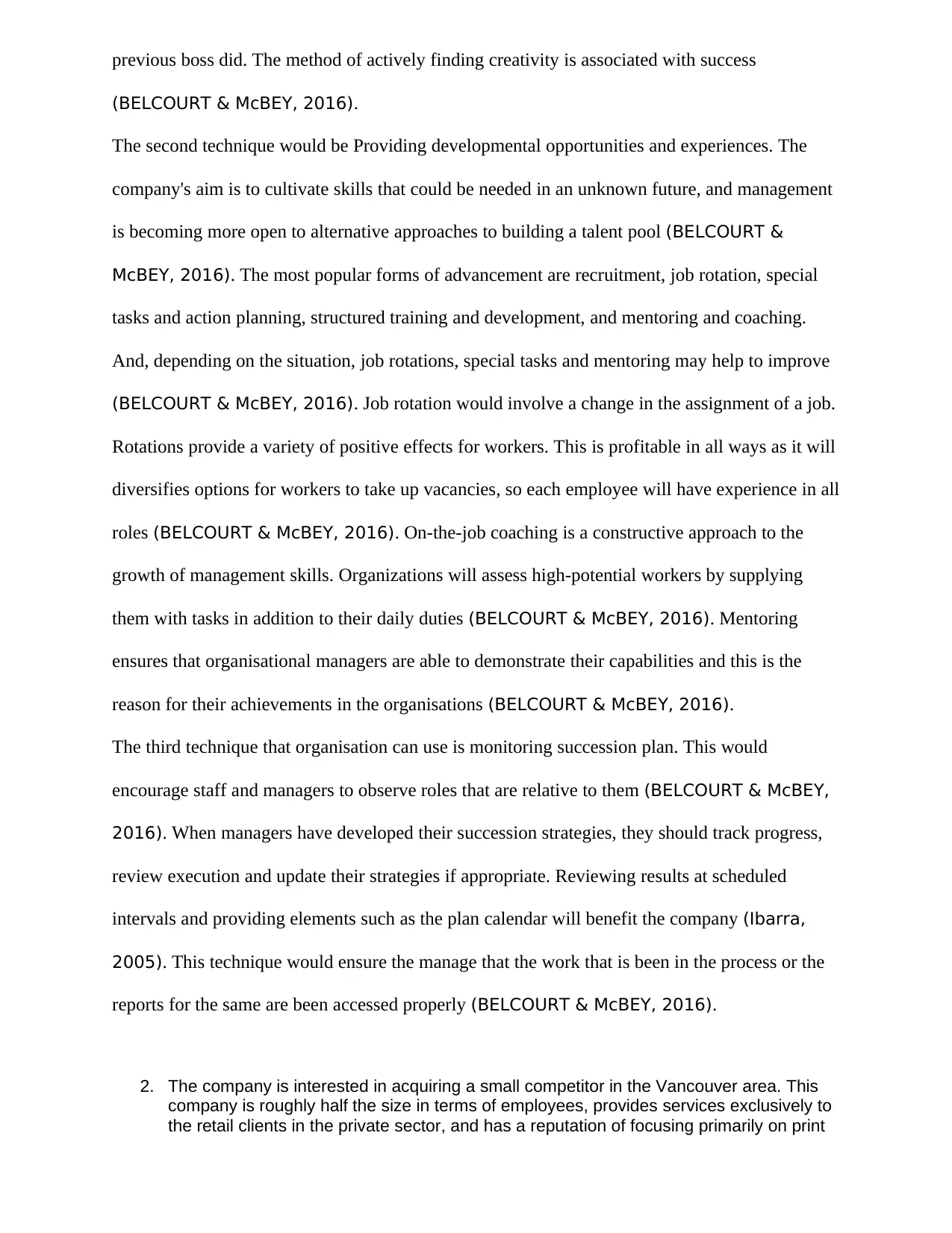
previous boss did. The method of actively finding creativity is associated with success
(BELCOURT & McBEY, 2016).
The second technique would be Providing developmental opportunities and experiences. The
company's aim is to cultivate skills that could be needed in an unknown future, and management
is becoming more open to alternative approaches to building a talent pool (BELCOURT &
McBEY, 2016). The most popular forms of advancement are recruitment, job rotation, special
tasks and action planning, structured training and development, and mentoring and coaching.
And, depending on the situation, job rotations, special tasks and mentoring may help to improve
(BELCOURT & McBEY, 2016). Job rotation would involve a change in the assignment of a job.
Rotations provide a variety of positive effects for workers. This is profitable in all ways as it will
diversifies options for workers to take up vacancies, so each employee will have experience in all
roles (BELCOURT & McBEY, 2016). On-the-job coaching is a constructive approach to the
growth of management skills. Organizations will assess high-potential workers by supplying
them with tasks in addition to their daily duties (BELCOURT & McBEY, 2016). Mentoring
ensures that organisational managers are able to demonstrate their capabilities and this is the
reason for their achievements in the organisations (BELCOURT & McBEY, 2016).
The third technique that organisation can use is monitoring succession plan. This would
encourage staff and managers to observe roles that are relative to them (BELCOURT & McBEY,
2016). When managers have developed their succession strategies, they should track progress,
review execution and update their strategies if appropriate. Reviewing results at scheduled
intervals and providing elements such as the plan calendar will benefit the company (Ibarra,
2005). This technique would ensure the manage that the work that is been in the process or the
reports for the same are been accessed properly (BELCOURT & McBEY, 2016).
2. The company is interested in acquiring a small competitor in the Vancouver area. This
company is roughly half the size in terms of employees, provides services exclusively to
the retail clients in the private sector, and has a reputation of focusing primarily on print
(BELCOURT & McBEY, 2016).
The second technique would be Providing developmental opportunities and experiences. The
company's aim is to cultivate skills that could be needed in an unknown future, and management
is becoming more open to alternative approaches to building a talent pool (BELCOURT &
McBEY, 2016). The most popular forms of advancement are recruitment, job rotation, special
tasks and action planning, structured training and development, and mentoring and coaching.
And, depending on the situation, job rotations, special tasks and mentoring may help to improve
(BELCOURT & McBEY, 2016). Job rotation would involve a change in the assignment of a job.
Rotations provide a variety of positive effects for workers. This is profitable in all ways as it will
diversifies options for workers to take up vacancies, so each employee will have experience in all
roles (BELCOURT & McBEY, 2016). On-the-job coaching is a constructive approach to the
growth of management skills. Organizations will assess high-potential workers by supplying
them with tasks in addition to their daily duties (BELCOURT & McBEY, 2016). Mentoring
ensures that organisational managers are able to demonstrate their capabilities and this is the
reason for their achievements in the organisations (BELCOURT & McBEY, 2016).
The third technique that organisation can use is monitoring succession plan. This would
encourage staff and managers to observe roles that are relative to them (BELCOURT & McBEY,
2016). When managers have developed their succession strategies, they should track progress,
review execution and update their strategies if appropriate. Reviewing results at scheduled
intervals and providing elements such as the plan calendar will benefit the company (Ibarra,
2005). This technique would ensure the manage that the work that is been in the process or the
reports for the same are been accessed properly (BELCOURT & McBEY, 2016).
2. The company is interested in acquiring a small competitor in the Vancouver area. This
company is roughly half the size in terms of employees, provides services exclusively to
the retail clients in the private sector, and has a reputation of focusing primarily on print
⊘ This is a preview!⊘
Do you want full access?
Subscribe today to unlock all pages.

Trusted by 1+ million students worldwide
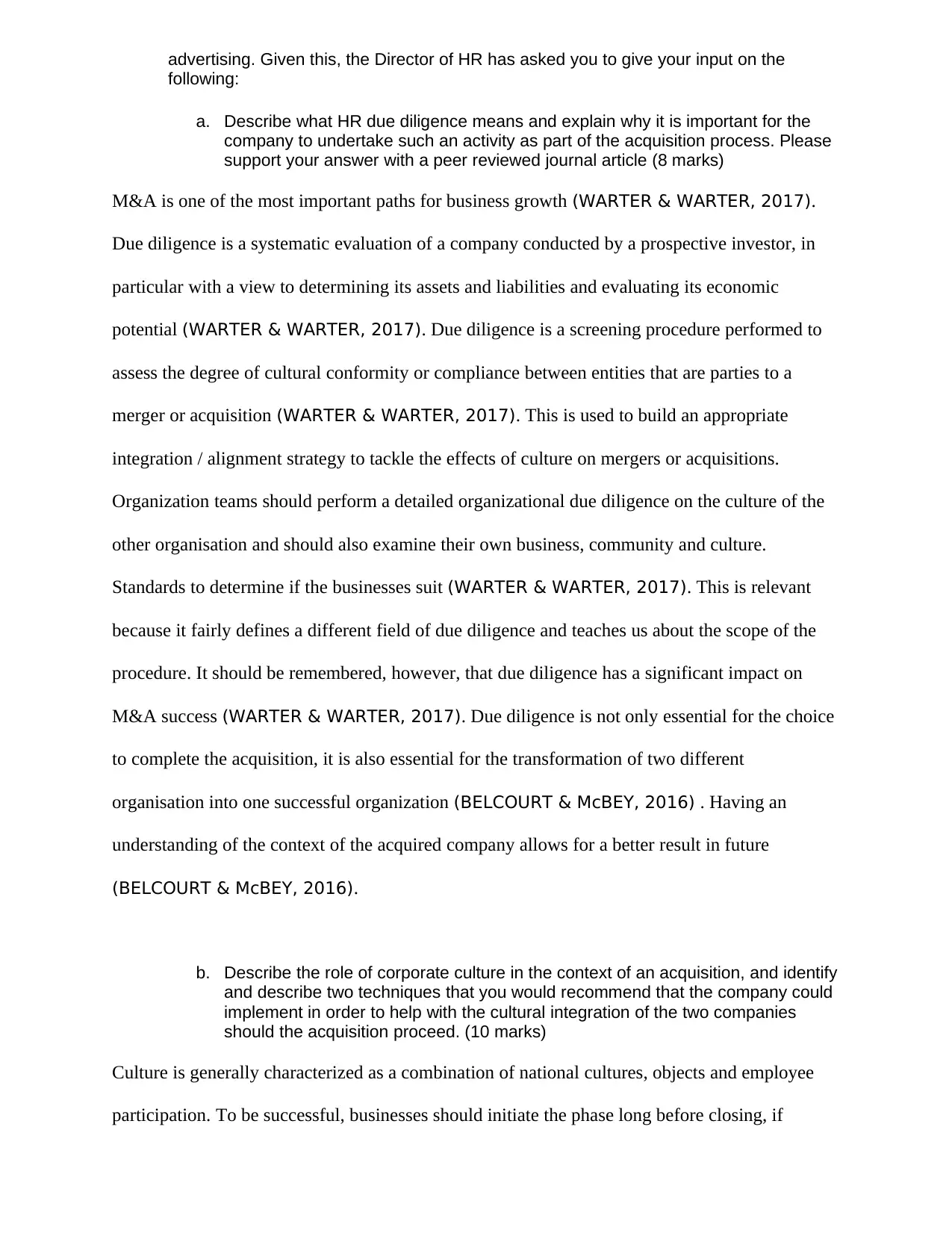
advertising. Given this, the Director of HR has asked you to give your input on the
following:
a. Describe what HR due diligence means and explain why it is important for the
company to undertake such an activity as part of the acquisition process. Please
support your answer with a peer reviewed journal article (8 marks)
M&A is one of the most important paths for business growth (WARTER & WARTER, 2017).
Due diligence is a systematic evaluation of a company conducted by a prospective investor, in
particular with a view to determining its assets and liabilities and evaluating its economic
potential (WARTER & WARTER, 2017). Due diligence is a screening procedure performed to
assess the degree of cultural conformity or compliance between entities that are parties to a
merger or acquisition (WARTER & WARTER, 2017). This is used to build an appropriate
integration / alignment strategy to tackle the effects of culture on mergers or acquisitions.
Organization teams should perform a detailed organizational due diligence on the culture of the
other organisation and should also examine their own business, community and culture.
Standards to determine if the businesses suit (WARTER & WARTER, 2017). This is relevant
because it fairly defines a different field of due diligence and teaches us about the scope of the
procedure. It should be remembered, however, that due diligence has a significant impact on
M&A success (WARTER & WARTER, 2017). Due diligence is not only essential for the choice
to complete the acquisition, it is also essential for the transformation of two different
organisation into one successful organization (BELCOURT & McBEY, 2016) . Having an
understanding of the context of the acquired company allows for a better result in future
(BELCOURT & McBEY, 2016).
b. Describe the role of corporate culture in the context of an acquisition, and identify
and describe two techniques that you would recommend that the company could
implement in order to help with the cultural integration of the two companies
should the acquisition proceed. (10 marks)
Culture is generally characterized as a combination of national cultures, objects and employee
participation. To be successful, businesses should initiate the phase long before closing, if
following:
a. Describe what HR due diligence means and explain why it is important for the
company to undertake such an activity as part of the acquisition process. Please
support your answer with a peer reviewed journal article (8 marks)
M&A is one of the most important paths for business growth (WARTER & WARTER, 2017).
Due diligence is a systematic evaluation of a company conducted by a prospective investor, in
particular with a view to determining its assets and liabilities and evaluating its economic
potential (WARTER & WARTER, 2017). Due diligence is a screening procedure performed to
assess the degree of cultural conformity or compliance between entities that are parties to a
merger or acquisition (WARTER & WARTER, 2017). This is used to build an appropriate
integration / alignment strategy to tackle the effects of culture on mergers or acquisitions.
Organization teams should perform a detailed organizational due diligence on the culture of the
other organisation and should also examine their own business, community and culture.
Standards to determine if the businesses suit (WARTER & WARTER, 2017). This is relevant
because it fairly defines a different field of due diligence and teaches us about the scope of the
procedure. It should be remembered, however, that due diligence has a significant impact on
M&A success (WARTER & WARTER, 2017). Due diligence is not only essential for the choice
to complete the acquisition, it is also essential for the transformation of two different
organisation into one successful organization (BELCOURT & McBEY, 2016) . Having an
understanding of the context of the acquired company allows for a better result in future
(BELCOURT & McBEY, 2016).
b. Describe the role of corporate culture in the context of an acquisition, and identify
and describe two techniques that you would recommend that the company could
implement in order to help with the cultural integration of the two companies
should the acquisition proceed. (10 marks)
Culture is generally characterized as a combination of national cultures, objects and employee
participation. To be successful, businesses should initiate the phase long before closing, if
Paraphrase This Document
Need a fresh take? Get an instant paraphrase of this document with our AI Paraphraser
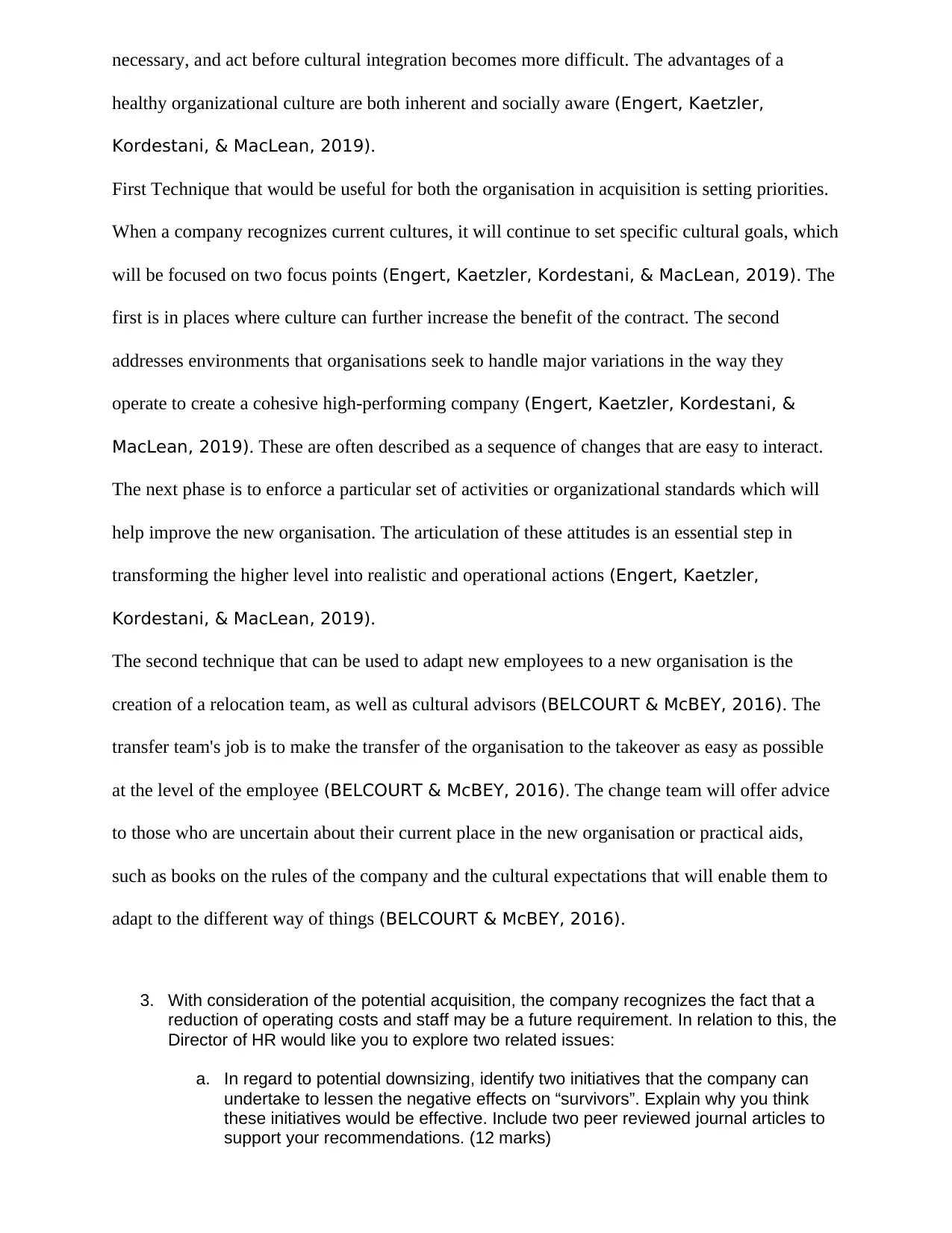
necessary, and act before cultural integration becomes more difficult. The advantages of a
healthy organizational culture are both inherent and socially aware (Engert, Kaetzler,
Kordestani, & MacLean, 2019).
First Technique that would be useful for both the organisation in acquisition is setting priorities.
When a company recognizes current cultures, it will continue to set specific cultural goals, which
will be focused on two focus points (Engert, Kaetzler, Kordestani, & MacLean, 2019). The
first is in places where culture can further increase the benefit of the contract. The second
addresses environments that organisations seek to handle major variations in the way they
operate to create a cohesive high-performing company (Engert, Kaetzler, Kordestani, &
MacLean, 2019). These are often described as a sequence of changes that are easy to interact.
The next phase is to enforce a particular set of activities or organizational standards which will
help improve the new organisation. The articulation of these attitudes is an essential step in
transforming the higher level into realistic and operational actions (Engert, Kaetzler,
Kordestani, & MacLean, 2019).
The second technique that can be used to adapt new employees to a new organisation is the
creation of a relocation team, as well as cultural advisors (BELCOURT & McBEY, 2016). The
transfer team's job is to make the transfer of the organisation to the takeover as easy as possible
at the level of the employee (BELCOURT & McBEY, 2016). The change team will offer advice
to those who are uncertain about their current place in the new organisation or practical aids,
such as books on the rules of the company and the cultural expectations that will enable them to
adapt to the different way of things (BELCOURT & McBEY, 2016).
3. With consideration of the potential acquisition, the company recognizes the fact that a
reduction of operating costs and staff may be a future requirement. In relation to this, the
Director of HR would like you to explore two related issues:
a. In regard to potential downsizing, identify two initiatives that the company can
undertake to lessen the negative effects on “survivors”. Explain why you think
these initiatives would be effective. Include two peer reviewed journal articles to
support your recommendations. (12 marks)
healthy organizational culture are both inherent and socially aware (Engert, Kaetzler,
Kordestani, & MacLean, 2019).
First Technique that would be useful for both the organisation in acquisition is setting priorities.
When a company recognizes current cultures, it will continue to set specific cultural goals, which
will be focused on two focus points (Engert, Kaetzler, Kordestani, & MacLean, 2019). The
first is in places where culture can further increase the benefit of the contract. The second
addresses environments that organisations seek to handle major variations in the way they
operate to create a cohesive high-performing company (Engert, Kaetzler, Kordestani, &
MacLean, 2019). These are often described as a sequence of changes that are easy to interact.
The next phase is to enforce a particular set of activities or organizational standards which will
help improve the new organisation. The articulation of these attitudes is an essential step in
transforming the higher level into realistic and operational actions (Engert, Kaetzler,
Kordestani, & MacLean, 2019).
The second technique that can be used to adapt new employees to a new organisation is the
creation of a relocation team, as well as cultural advisors (BELCOURT & McBEY, 2016). The
transfer team's job is to make the transfer of the organisation to the takeover as easy as possible
at the level of the employee (BELCOURT & McBEY, 2016). The change team will offer advice
to those who are uncertain about their current place in the new organisation or practical aids,
such as books on the rules of the company and the cultural expectations that will enable them to
adapt to the different way of things (BELCOURT & McBEY, 2016).
3. With consideration of the potential acquisition, the company recognizes the fact that a
reduction of operating costs and staff may be a future requirement. In relation to this, the
Director of HR would like you to explore two related issues:
a. In regard to potential downsizing, identify two initiatives that the company can
undertake to lessen the negative effects on “survivors”. Explain why you think
these initiatives would be effective. Include two peer reviewed journal articles to
support your recommendations. (12 marks)
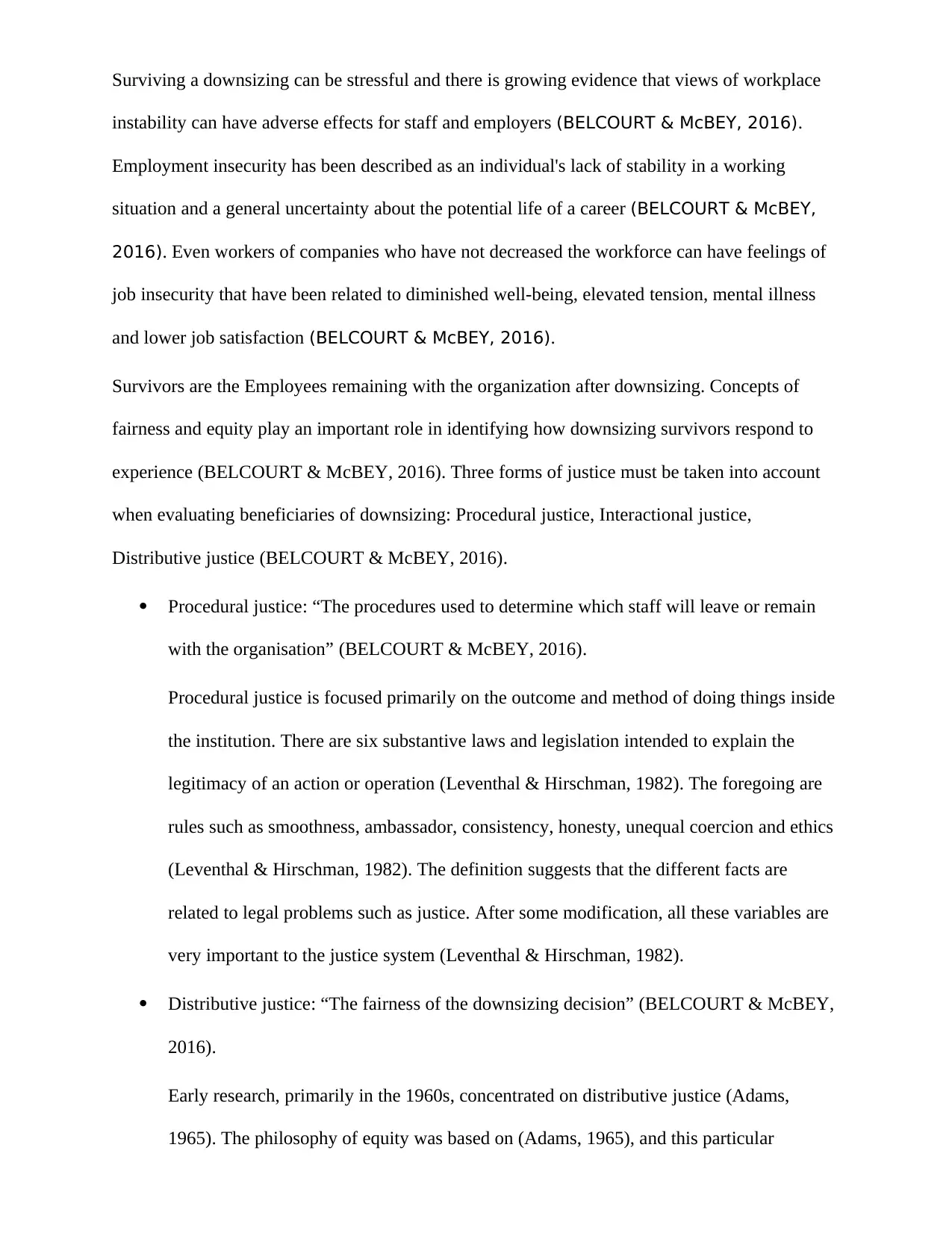
Surviving a downsizing can be stressful and there is growing evidence that views of workplace
instability can have adverse effects for staff and employers (BELCOURT & McBEY, 2016).
Employment insecurity has been described as an individual's lack of stability in a working
situation and a general uncertainty about the potential life of a career (BELCOURT & McBEY,
2016). Even workers of companies who have not decreased the workforce can have feelings of
job insecurity that have been related to diminished well-being, elevated tension, mental illness
and lower job satisfaction (BELCOURT & McBEY, 2016).
Survivors are the Employees remaining with the organization after downsizing. Concepts of
fairness and equity play an important role in identifying how downsizing survivors respond to
experience (BELCOURT & McBEY, 2016). Three forms of justice must be taken into account
when evaluating beneficiaries of downsizing: Procedural justice, Interactional justice,
Distributive justice (BELCOURT & McBEY, 2016).
Procedural justice: “The procedures used to determine which staff will leave or remain
with the organisation” (BELCOURT & McBEY, 2016).
Procedural justice is focused primarily on the outcome and method of doing things inside
the institution. There are six substantive laws and legislation intended to explain the
legitimacy of an action or operation (Leventhal & Hirschman, 1982). The foregoing are
rules such as smoothness, ambassador, consistency, honesty, unequal coercion and ethics
(Leventhal & Hirschman, 1982). The definition suggests that the different facts are
related to legal problems such as justice. After some modification, all these variables are
very important to the justice system (Leventhal & Hirschman, 1982).
Distributive justice: “The fairness of the downsizing decision” (BELCOURT & McBEY,
2016).
Early research, primarily in the 1960s, concentrated on distributive justice (Adams,
1965). The philosophy of equity was based on (Adams, 1965), and this particular
instability can have adverse effects for staff and employers (BELCOURT & McBEY, 2016).
Employment insecurity has been described as an individual's lack of stability in a working
situation and a general uncertainty about the potential life of a career (BELCOURT & McBEY,
2016). Even workers of companies who have not decreased the workforce can have feelings of
job insecurity that have been related to diminished well-being, elevated tension, mental illness
and lower job satisfaction (BELCOURT & McBEY, 2016).
Survivors are the Employees remaining with the organization after downsizing. Concepts of
fairness and equity play an important role in identifying how downsizing survivors respond to
experience (BELCOURT & McBEY, 2016). Three forms of justice must be taken into account
when evaluating beneficiaries of downsizing: Procedural justice, Interactional justice,
Distributive justice (BELCOURT & McBEY, 2016).
Procedural justice: “The procedures used to determine which staff will leave or remain
with the organisation” (BELCOURT & McBEY, 2016).
Procedural justice is focused primarily on the outcome and method of doing things inside
the institution. There are six substantive laws and legislation intended to explain the
legitimacy of an action or operation (Leventhal & Hirschman, 1982). The foregoing are
rules such as smoothness, ambassador, consistency, honesty, unequal coercion and ethics
(Leventhal & Hirschman, 1982). The definition suggests that the different facts are
related to legal problems such as justice. After some modification, all these variables are
very important to the justice system (Leventhal & Hirschman, 1982).
Distributive justice: “The fairness of the downsizing decision” (BELCOURT & McBEY,
2016).
Early research, primarily in the 1960s, concentrated on distributive justice (Adams,
1965). The philosophy of equity was based on (Adams, 1965), and this particular
⊘ This is a preview!⊘
Do you want full access?
Subscribe today to unlock all pages.

Trusted by 1+ million students worldwide
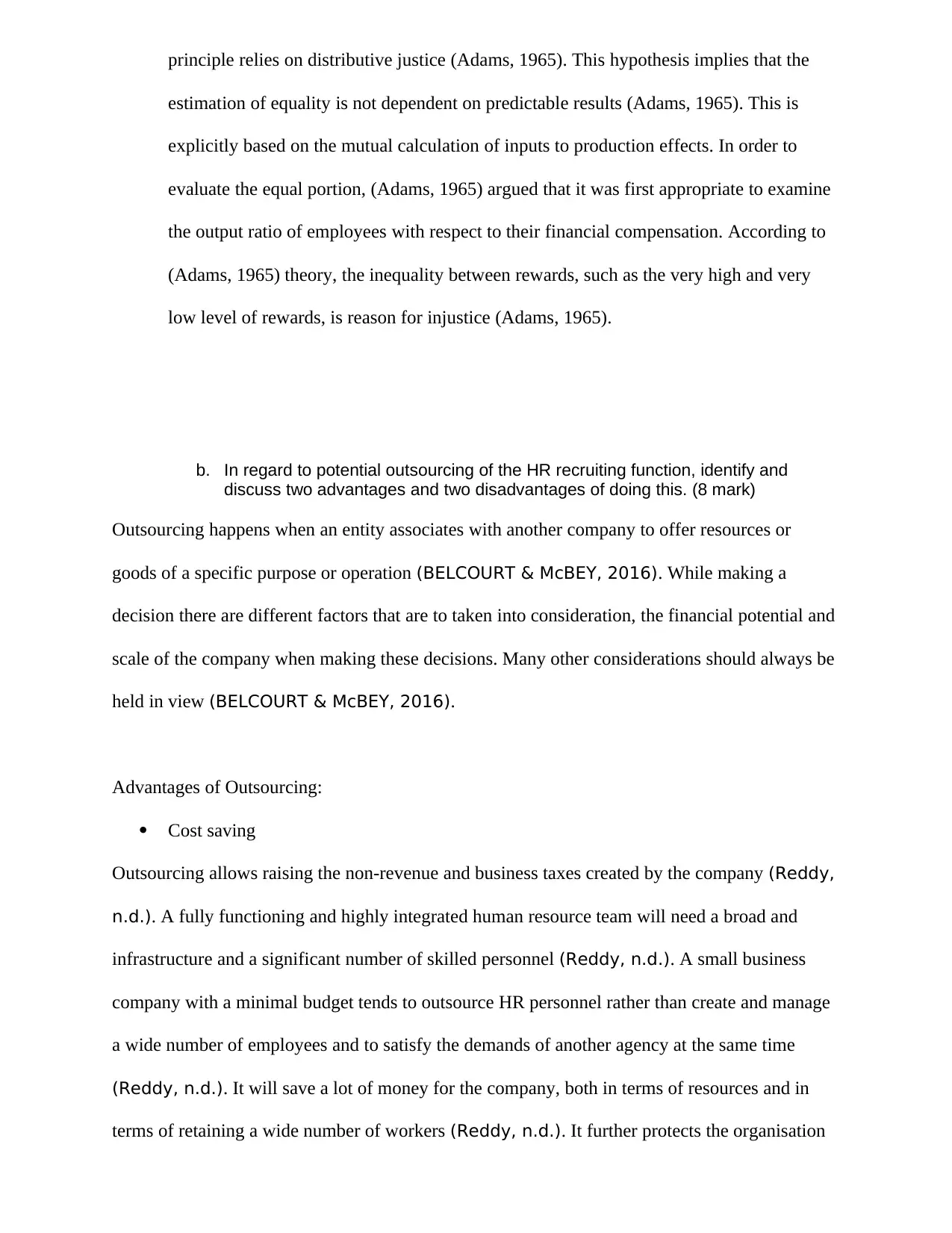
principle relies on distributive justice (Adams, 1965). This hypothesis implies that the
estimation of equality is not dependent on predictable results (Adams, 1965). This is
explicitly based on the mutual calculation of inputs to production effects. In order to
evaluate the equal portion, (Adams, 1965) argued that it was first appropriate to examine
the output ratio of employees with respect to their financial compensation. According to
(Adams, 1965) theory, the inequality between rewards, such as the very high and very
low level of rewards, is reason for injustice (Adams, 1965).
b. In regard to potential outsourcing of the HR recruiting function, identify and
discuss two advantages and two disadvantages of doing this. (8 mark)
Outsourcing happens when an entity associates with another company to offer resources or
goods of a specific purpose or operation (BELCOURT & McBEY, 2016). While making a
decision there are different factors that are to taken into consideration, the financial potential and
scale of the company when making these decisions. Many other considerations should always be
held in view (BELCOURT & McBEY, 2016).
Advantages of Outsourcing:
Cost saving
Outsourcing allows raising the non-revenue and business taxes created by the company (Reddy,
n.d.). A fully functioning and highly integrated human resource team will need a broad and
infrastructure and a significant number of skilled personnel (Reddy, n.d.). A small business
company with a minimal budget tends to outsource HR personnel rather than create and manage
a wide number of employees and to satisfy the demands of another agency at the same time
(Reddy, n.d.). It will save a lot of money for the company, both in terms of resources and in
terms of retaining a wide number of workers (Reddy, n.d.). It further protects the organisation
estimation of equality is not dependent on predictable results (Adams, 1965). This is
explicitly based on the mutual calculation of inputs to production effects. In order to
evaluate the equal portion, (Adams, 1965) argued that it was first appropriate to examine
the output ratio of employees with respect to their financial compensation. According to
(Adams, 1965) theory, the inequality between rewards, such as the very high and very
low level of rewards, is reason for injustice (Adams, 1965).
b. In regard to potential outsourcing of the HR recruiting function, identify and
discuss two advantages and two disadvantages of doing this. (8 mark)
Outsourcing happens when an entity associates with another company to offer resources or
goods of a specific purpose or operation (BELCOURT & McBEY, 2016). While making a
decision there are different factors that are to taken into consideration, the financial potential and
scale of the company when making these decisions. Many other considerations should always be
held in view (BELCOURT & McBEY, 2016).
Advantages of Outsourcing:
Cost saving
Outsourcing allows raising the non-revenue and business taxes created by the company (Reddy,
n.d.). A fully functioning and highly integrated human resource team will need a broad and
infrastructure and a significant number of skilled personnel (Reddy, n.d.). A small business
company with a minimal budget tends to outsource HR personnel rather than create and manage
a wide number of employees and to satisfy the demands of another agency at the same time
(Reddy, n.d.). It will save a lot of money for the company, both in terms of resources and in
terms of retaining a wide number of workers (Reddy, n.d.). It further protects the organisation
Paraphrase This Document
Need a fresh take? Get an instant paraphrase of this document with our AI Paraphraser
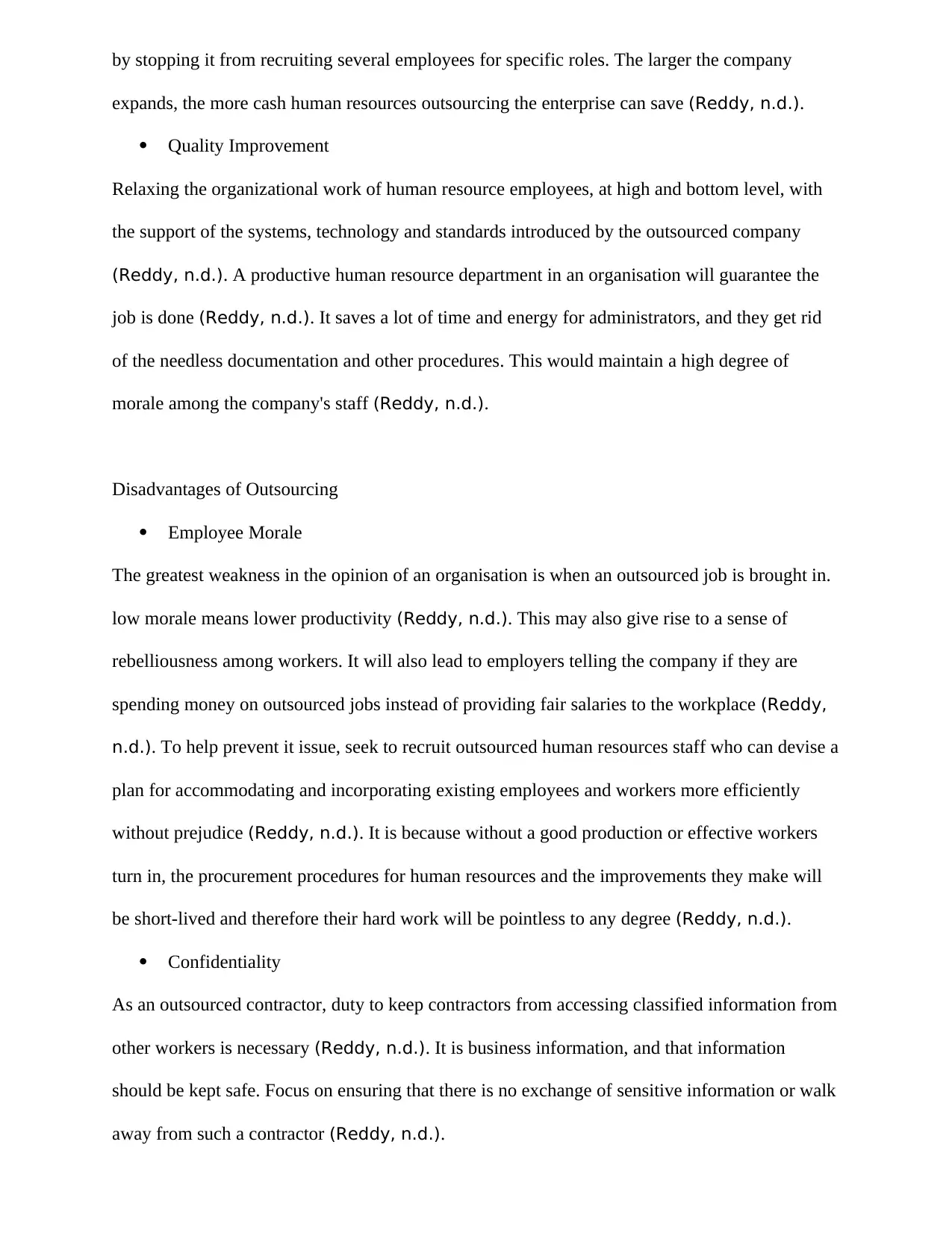
by stopping it from recruiting several employees for specific roles. The larger the company
expands, the more cash human resources outsourcing the enterprise can save (Reddy, n.d.).
Quality Improvement
Relaxing the organizational work of human resource employees, at high and bottom level, with
the support of the systems, technology and standards introduced by the outsourced company
(Reddy, n.d.). A productive human resource department in an organisation will guarantee the
job is done (Reddy, n.d.). It saves a lot of time and energy for administrators, and they get rid
of the needless documentation and other procedures. This would maintain a high degree of
morale among the company's staff (Reddy, n.d.).
Disadvantages of Outsourcing
Employee Morale
The greatest weakness in the opinion of an organisation is when an outsourced job is brought in.
low morale means lower productivity (Reddy, n.d.). This may also give rise to a sense of
rebelliousness among workers. It will also lead to employers telling the company if they are
spending money on outsourced jobs instead of providing fair salaries to the workplace (Reddy,
n.d.). To help prevent it issue, seek to recruit outsourced human resources staff who can devise a
plan for accommodating and incorporating existing employees and workers more efficiently
without prejudice (Reddy, n.d.). It is because without a good production or effective workers
turn in, the procurement procedures for human resources and the improvements they make will
be short-lived and therefore their hard work will be pointless to any degree (Reddy, n.d.).
Confidentiality
As an outsourced contractor, duty to keep contractors from accessing classified information from
other workers is necessary (Reddy, n.d.). It is business information, and that information
should be kept safe. Focus on ensuring that there is no exchange of sensitive information or walk
away from such a contractor (Reddy, n.d.).
expands, the more cash human resources outsourcing the enterprise can save (Reddy, n.d.).
Quality Improvement
Relaxing the organizational work of human resource employees, at high and bottom level, with
the support of the systems, technology and standards introduced by the outsourced company
(Reddy, n.d.). A productive human resource department in an organisation will guarantee the
job is done (Reddy, n.d.). It saves a lot of time and energy for administrators, and they get rid
of the needless documentation and other procedures. This would maintain a high degree of
morale among the company's staff (Reddy, n.d.).
Disadvantages of Outsourcing
Employee Morale
The greatest weakness in the opinion of an organisation is when an outsourced job is brought in.
low morale means lower productivity (Reddy, n.d.). This may also give rise to a sense of
rebelliousness among workers. It will also lead to employers telling the company if they are
spending money on outsourced jobs instead of providing fair salaries to the workplace (Reddy,
n.d.). To help prevent it issue, seek to recruit outsourced human resources staff who can devise a
plan for accommodating and incorporating existing employees and workers more efficiently
without prejudice (Reddy, n.d.). It is because without a good production or effective workers
turn in, the procurement procedures for human resources and the improvements they make will
be short-lived and therefore their hard work will be pointless to any degree (Reddy, n.d.).
Confidentiality
As an outsourced contractor, duty to keep contractors from accessing classified information from
other workers is necessary (Reddy, n.d.). It is business information, and that information
should be kept safe. Focus on ensuring that there is no exchange of sensitive information or walk
away from such a contractor (Reddy, n.d.).
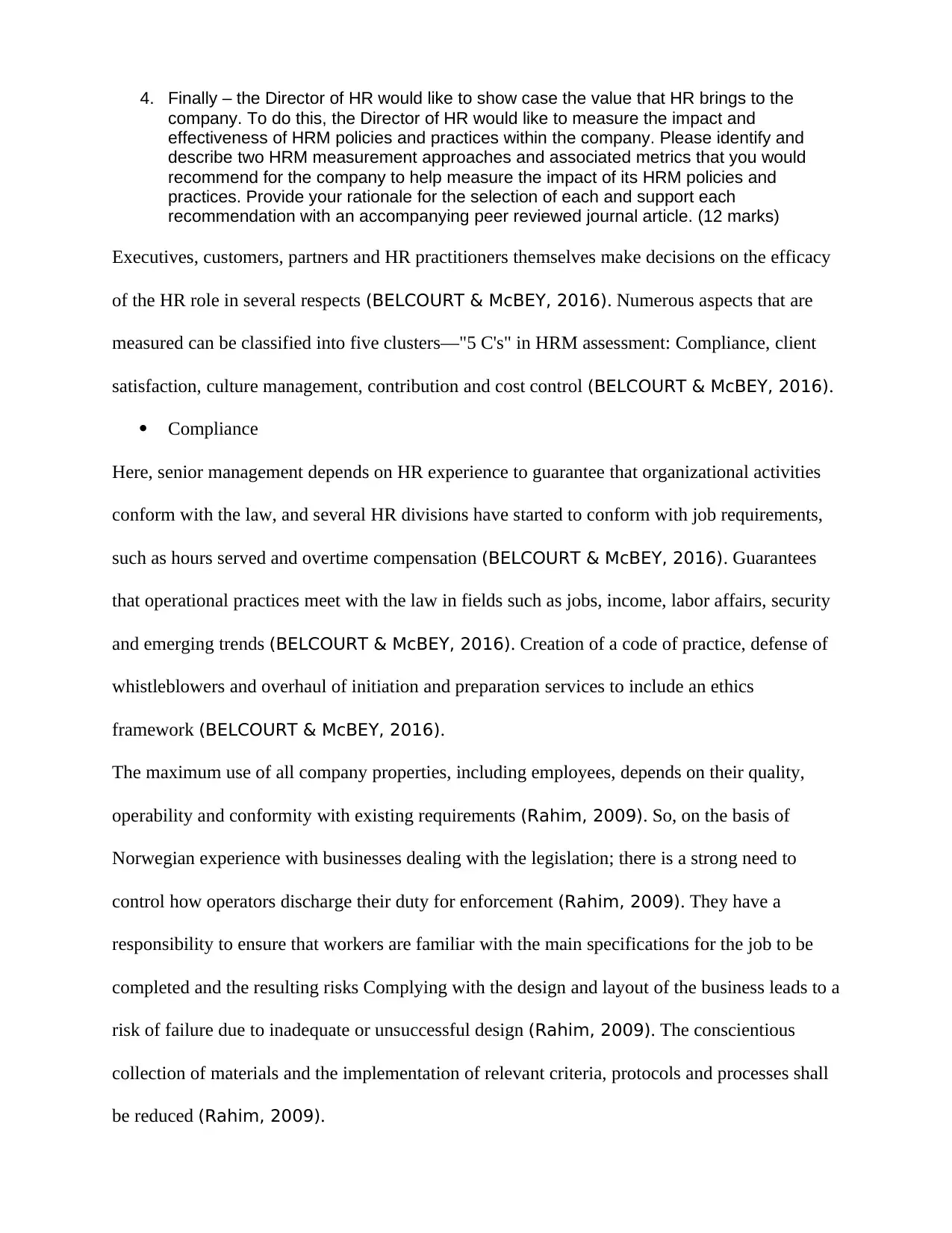
4. Finally – the Director of HR would like to show case the value that HR brings to the
company. To do this, the Director of HR would like to measure the impact and
effectiveness of HRM policies and practices within the company. Please identify and
describe two HRM measurement approaches and associated metrics that you would
recommend for the company to help measure the impact of its HRM policies and
practices. Provide your rationale for the selection of each and support each
recommendation with an accompanying peer reviewed journal article. (12 marks)
Executives, customers, partners and HR practitioners themselves make decisions on the efficacy
of the HR role in several respects (BELCOURT & McBEY, 2016). Numerous aspects that are
measured can be classified into five clusters—"5 C's" in HRM assessment: Compliance, client
satisfaction, culture management, contribution and cost control (BELCOURT & McBEY, 2016).
Compliance
Here, senior management depends on HR experience to guarantee that organizational activities
conform with the law, and several HR divisions have started to conform with job requirements,
such as hours served and overtime compensation (BELCOURT & McBEY, 2016). Guarantees
that operational practices meet with the law in fields such as jobs, income, labor affairs, security
and emerging trends (BELCOURT & McBEY, 2016). Creation of a code of practice, defense of
whistleblowers and overhaul of initiation and preparation services to include an ethics
framework (BELCOURT & McBEY, 2016).
The maximum use of all company properties, including employees, depends on their quality,
operability and conformity with existing requirements (Rahim, 2009). So, on the basis of
Norwegian experience with businesses dealing with the legislation; there is a strong need to
control how operators discharge their duty for enforcement (Rahim, 2009). They have a
responsibility to ensure that workers are familiar with the main specifications for the job to be
completed and the resulting risks Complying with the design and layout of the business leads to a
risk of failure due to inadequate or unsuccessful design (Rahim, 2009). The conscientious
collection of materials and the implementation of relevant criteria, protocols and processes shall
be reduced (Rahim, 2009).
company. To do this, the Director of HR would like to measure the impact and
effectiveness of HRM policies and practices within the company. Please identify and
describe two HRM measurement approaches and associated metrics that you would
recommend for the company to help measure the impact of its HRM policies and
practices. Provide your rationale for the selection of each and support each
recommendation with an accompanying peer reviewed journal article. (12 marks)
Executives, customers, partners and HR practitioners themselves make decisions on the efficacy
of the HR role in several respects (BELCOURT & McBEY, 2016). Numerous aspects that are
measured can be classified into five clusters—"5 C's" in HRM assessment: Compliance, client
satisfaction, culture management, contribution and cost control (BELCOURT & McBEY, 2016).
Compliance
Here, senior management depends on HR experience to guarantee that organizational activities
conform with the law, and several HR divisions have started to conform with job requirements,
such as hours served and overtime compensation (BELCOURT & McBEY, 2016). Guarantees
that operational practices meet with the law in fields such as jobs, income, labor affairs, security
and emerging trends (BELCOURT & McBEY, 2016). Creation of a code of practice, defense of
whistleblowers and overhaul of initiation and preparation services to include an ethics
framework (BELCOURT & McBEY, 2016).
The maximum use of all company properties, including employees, depends on their quality,
operability and conformity with existing requirements (Rahim, 2009). So, on the basis of
Norwegian experience with businesses dealing with the legislation; there is a strong need to
control how operators discharge their duty for enforcement (Rahim, 2009). They have a
responsibility to ensure that workers are familiar with the main specifications for the job to be
completed and the resulting risks Complying with the design and layout of the business leads to a
risk of failure due to inadequate or unsuccessful design (Rahim, 2009). The conscientious
collection of materials and the implementation of relevant criteria, protocols and processes shall
be reduced (Rahim, 2009).
⊘ This is a preview!⊘
Do you want full access?
Subscribe today to unlock all pages.

Trusted by 1+ million students worldwide
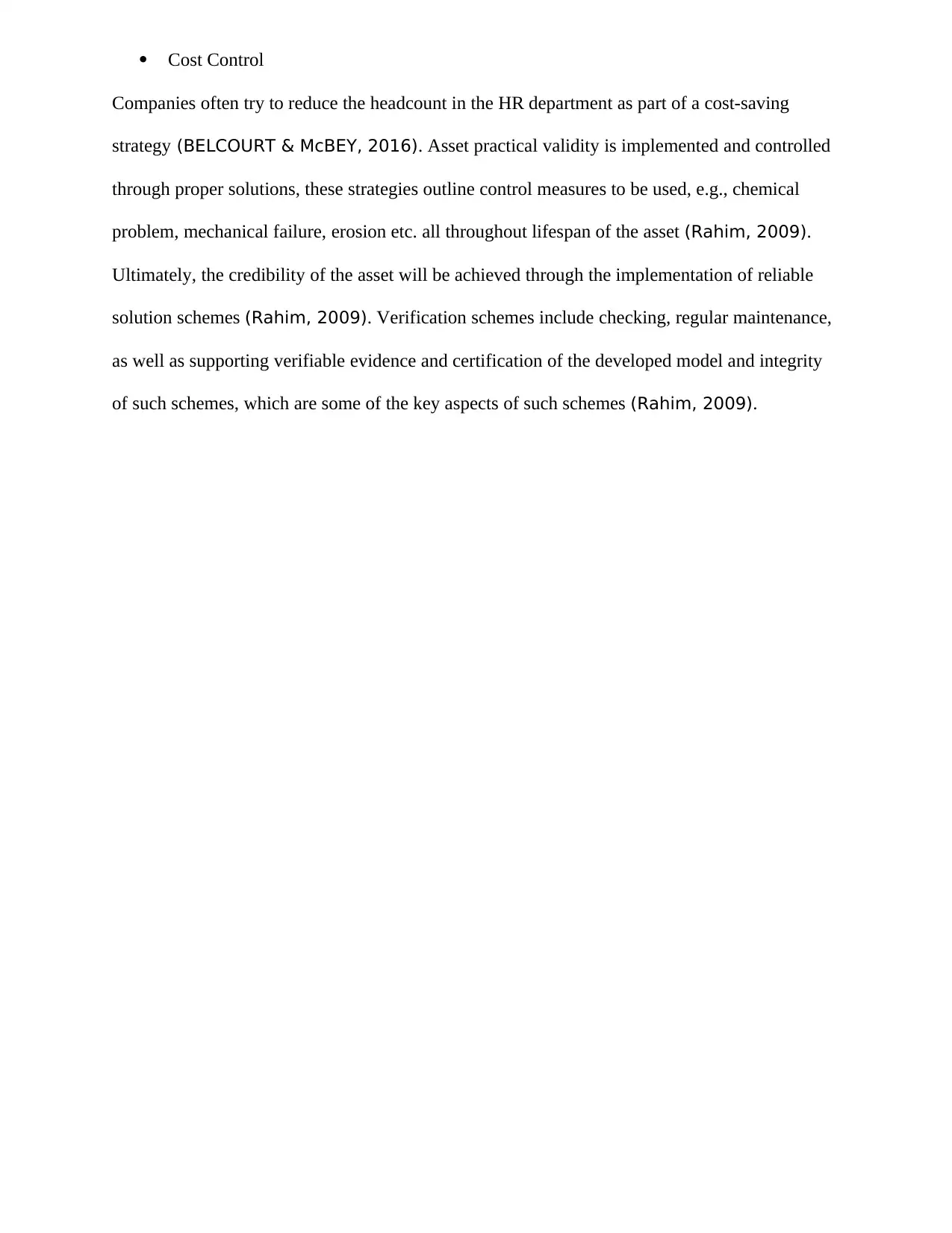
Cost Control
Companies often try to reduce the headcount in the HR department as part of a cost-saving
strategy (BELCOURT & McBEY, 2016). Asset practical validity is implemented and controlled
through proper solutions, these strategies outline control measures to be used, e.g., chemical
problem, mechanical failure, erosion etc. all throughout lifespan of the asset (Rahim, 2009).
Ultimately, the credibility of the asset will be achieved through the implementation of reliable
solution schemes (Rahim, 2009). Verification schemes include checking, regular maintenance,
as well as supporting verifiable evidence and certification of the developed model and integrity
of such schemes, which are some of the key aspects of such schemes (Rahim, 2009).
Companies often try to reduce the headcount in the HR department as part of a cost-saving
strategy (BELCOURT & McBEY, 2016). Asset practical validity is implemented and controlled
through proper solutions, these strategies outline control measures to be used, e.g., chemical
problem, mechanical failure, erosion etc. all throughout lifespan of the asset (Rahim, 2009).
Ultimately, the credibility of the asset will be achieved through the implementation of reliable
solution schemes (Rahim, 2009). Verification schemes include checking, regular maintenance,
as well as supporting verifiable evidence and certification of the developed model and integrity
of such schemes, which are some of the key aspects of such schemes (Rahim, 2009).
Paraphrase This Document
Need a fresh take? Get an instant paraphrase of this document with our AI Paraphraser
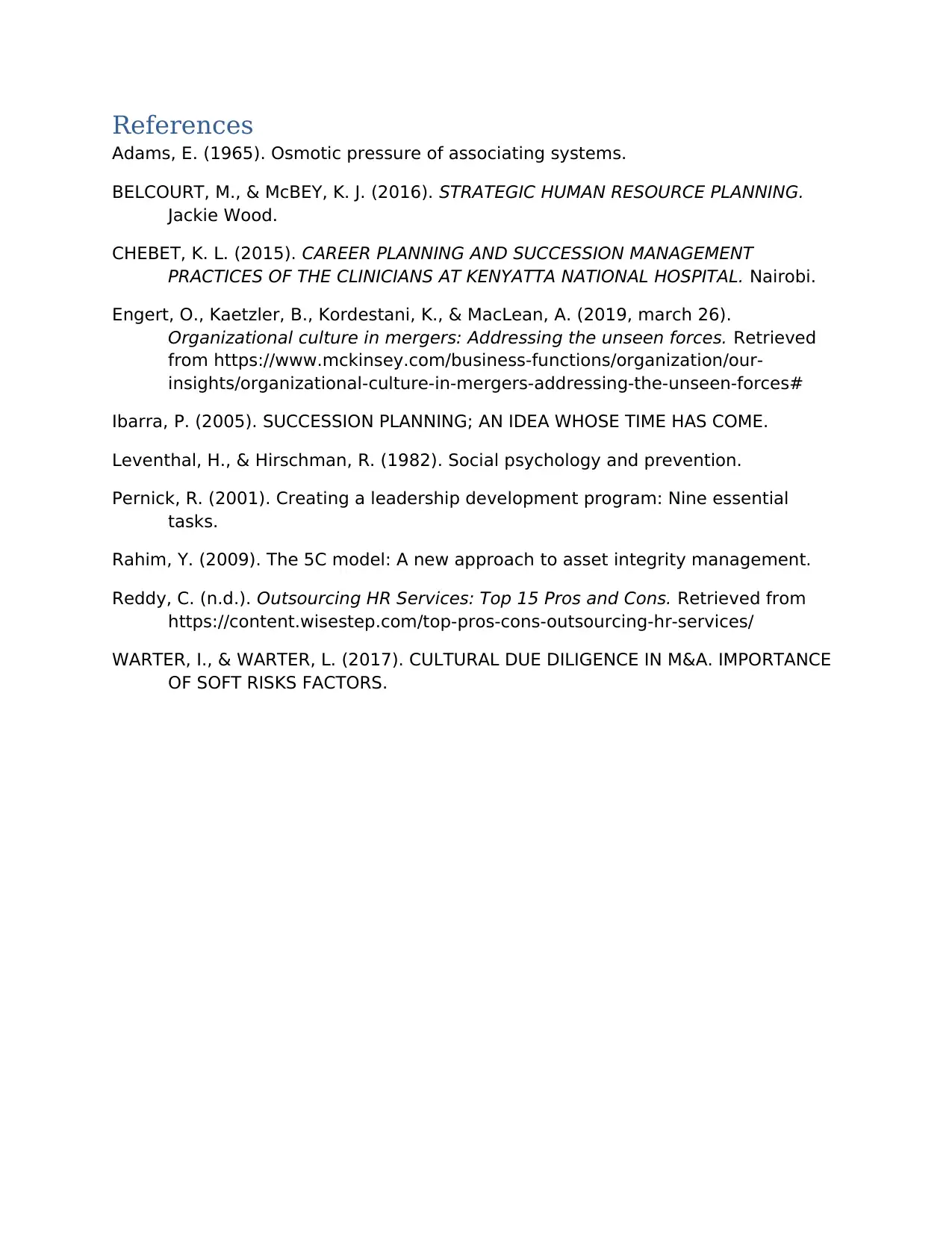
References
Adams, E. (1965). Osmotic pressure of associating systems.
BELCOURT, M., & McBEY, K. J. (2016). STRATEGIC HUMAN RESOURCE PLANNING.
Jackie Wood.
CHEBET, K. L. (2015). CAREER PLANNING AND SUCCESSION MANAGEMENT
PRACTICES OF THE CLINICIANS AT KENYATTA NATIONAL HOSPITAL. Nairobi.
Engert, O., Kaetzler, B., Kordestani, K., & MacLean, A. (2019, march 26).
Organizational culture in mergers: Addressing the unseen forces. Retrieved
from https://www.mckinsey.com/business-functions/organization/our-
insights/organizational-culture-in-mergers-addressing-the-unseen-forces#
Ibarra, P. (2005). SUCCESSION PLANNING; AN IDEA WHOSE TIME HAS COME.
Leventhal, H., & Hirschman, R. (1982). Social psychology and prevention.
Pernick, R. (2001). Creating a leadership development program: Nine essential
tasks.
Rahim, Y. (2009). The 5C model: A new approach to asset integrity management.
Reddy, C. (n.d.). Outsourcing HR Services: Top 15 Pros and Cons. Retrieved from
https://content.wisestep.com/top-pros-cons-outsourcing-hr-services/
WARTER, I., & WARTER, L. (2017). CULTURAL DUE DILIGENCE IN M&A. IMPORTANCE
OF SOFT RISKS FACTORS.
Adams, E. (1965). Osmotic pressure of associating systems.
BELCOURT, M., & McBEY, K. J. (2016). STRATEGIC HUMAN RESOURCE PLANNING.
Jackie Wood.
CHEBET, K. L. (2015). CAREER PLANNING AND SUCCESSION MANAGEMENT
PRACTICES OF THE CLINICIANS AT KENYATTA NATIONAL HOSPITAL. Nairobi.
Engert, O., Kaetzler, B., Kordestani, K., & MacLean, A. (2019, march 26).
Organizational culture in mergers: Addressing the unseen forces. Retrieved
from https://www.mckinsey.com/business-functions/organization/our-
insights/organizational-culture-in-mergers-addressing-the-unseen-forces#
Ibarra, P. (2005). SUCCESSION PLANNING; AN IDEA WHOSE TIME HAS COME.
Leventhal, H., & Hirschman, R. (1982). Social psychology and prevention.
Pernick, R. (2001). Creating a leadership development program: Nine essential
tasks.
Rahim, Y. (2009). The 5C model: A new approach to asset integrity management.
Reddy, C. (n.d.). Outsourcing HR Services: Top 15 Pros and Cons. Retrieved from
https://content.wisestep.com/top-pros-cons-outsourcing-hr-services/
WARTER, I., & WARTER, L. (2017). CULTURAL DUE DILIGENCE IN M&A. IMPORTANCE
OF SOFT RISKS FACTORS.
1 out of 11
Related Documents
Your All-in-One AI-Powered Toolkit for Academic Success.
+13062052269
info@desklib.com
Available 24*7 on WhatsApp / Email
![[object Object]](/_next/static/media/star-bottom.7253800d.svg)
Unlock your academic potential
Copyright © 2020–2025 A2Z Services. All Rights Reserved. Developed and managed by ZUCOL.





